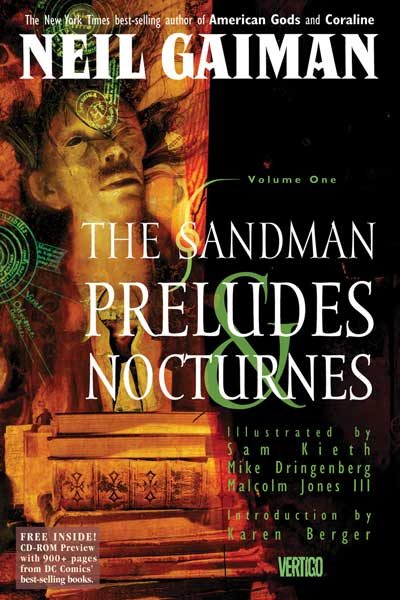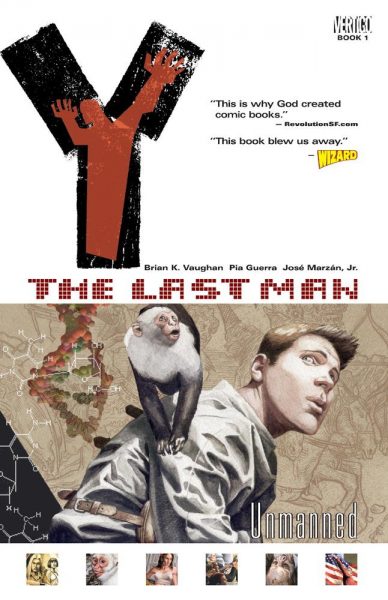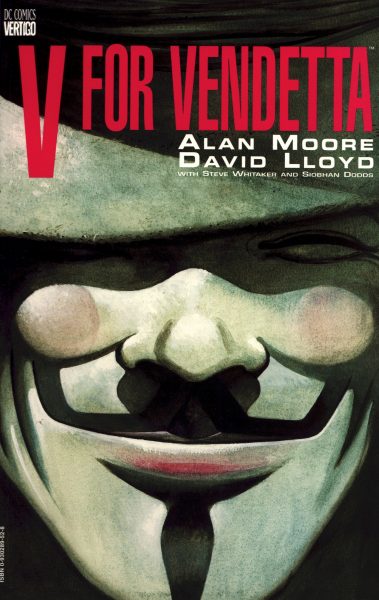Why Vertigo Comics’ Success is Important to Comics
This wasn’t the best week for DC Comics. On top of renewed attention paid to allegations of sexual harassment by one of DC’s editors, they also made the wrong kind of headlines when they
fired Shelly Bond, the Executive Editor of the Vertigo Comics imprint. While hirings and firings are not especially uncommon, even in the comics industry, Bond’s firing was perceived negatively by many people for a couple of reasons.
For one, she has a tremendous reputation among creators. There were many who came out in support of her after the announcement that she had been let go. Secondly, there were rumblings that Bond was the scapegoat for Vertigo’s recent struggles even though her hands were often tied by executives.

The firing of Bond brought more attention to the fact that Vertigo Comics hasn’t had the same kind of success in the past five years as in the past. Throughout its history, Vertigo Comics has been essential to the growth of comic books as an artistic medium and to the establishment of top-end comic book creators. Some of the legendary titles published by Vertigo include
The Sandman,
Y: The Last Man,
Saga of the Swamp Thing,
Animal Man,
Hellblazer,
100 Bullets,
Doom Patrol,
Fables,
Preacher,
V for Vendetta,
A History of Violence,
DMZ,
iZombie,
Scalped,
Astro City,
Transmetropolitan,
Sweet Tooth, and many others.
Vertigo Comics originally began in 1983 when DC Comics decided that there were stories being presented by creators that wouldn’t necessary pass the Comics Code Authority but were still worthy of getting published. By separating Vertigo Comics as an imprint of DC, it allowed the publisher to take more chances, both in terms of content and publishing format. The burgeoning direct market of stores certainly helped make this a reality. Rather than comics having to be sold in spinner racks at places like department stores and 7-11s, there were dedicated stores to comic books that could have deep stock, had the ability to offer books, and could keep “mature” content separate from the regular superhero stuff.

The lauded history of Vertigo Comics owes a lot to one person – editor Karen Berger. She was already helping edit titles at DC that were pushing boundaries, designed with a “For Mature Readers” tag, so she was given the task of creating a separate imprint by the then DC team in charge. Berger already had established working relationships with emerging comic book talents like Neil Gaiman and Alan Moore, so she was quickly able to attract other daring writers and artists. Gradually, Vertigo Comics became synonymous with intelligent and creatively-daring comic books. Many Vertigo titles won top industry awards such as the Harvey and Eisner Awards. TV and movie adaptations of numerous Vertigo properties were developed.
However, when the nominations for the 2016 Eisner Awards were
announced last week, there was only one nomination for a Vertigo Comics work ("Black Death in America" by Tom King and John Paul Leon from
Vertigo Quarterly: Black). When viewed from afar, the fact was a little shocking, but it’s also not entirely unexpected when you look at the actual nominations from other publishers. So how did we get from the point where Vertigo was the industry leader in artistic comics to now, when it's generally admitted that Vertigo is struggling?

To some degree, Vertigo Comics is a victim of its own success. Berger and her staff helped nurture top talents that went on to inspire the next generation of creative talent. Many of those people came to publish works at Vertigo. However, as more and more creators became interested in comics, there were other people who would eventually filter to other publishers. In the early 2000s, Image Comics transitioned from a superhero-themed publisher to offering more Vertigo-like titles. Many of these became successful and Image eventually started becoming the go-to place for creators looking to push the limits. It’s worth noting that Image Comics has 18 Eisner Award nominees this year.
The recent struggles of Vertigo probably cannot be totally separated from the fluctuations of DC Comics in general. Vertigo had published titles of character that also belonged in the DC Universe. However, in 2010, DC made the decision to bring all of those characters back to the regular DC Universe and made Vertigo a solely creator-owned line. Then, DC Comics rebooted its own universe with the “New 52” in 2011. Berger left DC/Vertigo in 2012, and many of its most popular series, such as
Fables, had already or were beginning to wrap up. Although these events individually do not explain Vertigo’s problems, it shows some recent instability that perhaps indicates why the line’s titles haven’t been as well received in the past five or six years.

So why is the health and success of Vertigo Comics vital to the industry if Image Comics and other publishers have taken up the mantle of what Vertigo stood for? Even with the success of Image, there are still only so many outlets for creative storytellers in comics. Likewise, that Vertigo is a branch of DC Comics, itself a branch of Warner Brothers, is important. Bold and daring comics should not just be the realm of independent publishers. If mainstream comic publishers stop publishing titles like those from Vertigo, it’s a loss both for the medium and for the publishers. DC still seems committed to Vertigo, and they recently announced a separate imprint helmed by Gerard Way called
Young Animal, which seems devoted to “out there” comics. Still, it is important for the long-term strength of comic books if Vertigo gets back to the acclaim and success it once had.
 The firing of Bond brought more attention to the fact that Vertigo Comics hasn’t had the same kind of success in the past five years as in the past. Throughout its history, Vertigo Comics has been essential to the growth of comic books as an artistic medium and to the establishment of top-end comic book creators. Some of the legendary titles published by Vertigo include The Sandman, Y: The Last Man, Saga of the Swamp Thing, Animal Man, Hellblazer, 100 Bullets, Doom Patrol, Fables, Preacher, V for Vendetta, A History of Violence, DMZ, iZombie, Scalped, Astro City, Transmetropolitan, Sweet Tooth, and many others.
Vertigo Comics originally began in 1983 when DC Comics decided that there were stories being presented by creators that wouldn’t necessary pass the Comics Code Authority but were still worthy of getting published. By separating Vertigo Comics as an imprint of DC, it allowed the publisher to take more chances, both in terms of content and publishing format. The burgeoning direct market of stores certainly helped make this a reality. Rather than comics having to be sold in spinner racks at places like department stores and 7-11s, there were dedicated stores to comic books that could have deep stock, had the ability to offer books, and could keep “mature” content separate from the regular superhero stuff.
The firing of Bond brought more attention to the fact that Vertigo Comics hasn’t had the same kind of success in the past five years as in the past. Throughout its history, Vertigo Comics has been essential to the growth of comic books as an artistic medium and to the establishment of top-end comic book creators. Some of the legendary titles published by Vertigo include The Sandman, Y: The Last Man, Saga of the Swamp Thing, Animal Man, Hellblazer, 100 Bullets, Doom Patrol, Fables, Preacher, V for Vendetta, A History of Violence, DMZ, iZombie, Scalped, Astro City, Transmetropolitan, Sweet Tooth, and many others.
Vertigo Comics originally began in 1983 when DC Comics decided that there were stories being presented by creators that wouldn’t necessary pass the Comics Code Authority but were still worthy of getting published. By separating Vertigo Comics as an imprint of DC, it allowed the publisher to take more chances, both in terms of content and publishing format. The burgeoning direct market of stores certainly helped make this a reality. Rather than comics having to be sold in spinner racks at places like department stores and 7-11s, there were dedicated stores to comic books that could have deep stock, had the ability to offer books, and could keep “mature” content separate from the regular superhero stuff.
 The lauded history of Vertigo Comics owes a lot to one person – editor Karen Berger. She was already helping edit titles at DC that were pushing boundaries, designed with a “For Mature Readers” tag, so she was given the task of creating a separate imprint by the then DC team in charge. Berger already had established working relationships with emerging comic book talents like Neil Gaiman and Alan Moore, so she was quickly able to attract other daring writers and artists. Gradually, Vertigo Comics became synonymous with intelligent and creatively-daring comic books. Many Vertigo titles won top industry awards such as the Harvey and Eisner Awards. TV and movie adaptations of numerous Vertigo properties were developed.
However, when the nominations for the 2016 Eisner Awards were announced last week, there was only one nomination for a Vertigo Comics work ("Black Death in America" by Tom King and John Paul Leon from Vertigo Quarterly: Black). When viewed from afar, the fact was a little shocking, but it’s also not entirely unexpected when you look at the actual nominations from other publishers. So how did we get from the point where Vertigo was the industry leader in artistic comics to now, when it's generally admitted that Vertigo is struggling?
The lauded history of Vertigo Comics owes a lot to one person – editor Karen Berger. She was already helping edit titles at DC that were pushing boundaries, designed with a “For Mature Readers” tag, so she was given the task of creating a separate imprint by the then DC team in charge. Berger already had established working relationships with emerging comic book talents like Neil Gaiman and Alan Moore, so she was quickly able to attract other daring writers and artists. Gradually, Vertigo Comics became synonymous with intelligent and creatively-daring comic books. Many Vertigo titles won top industry awards such as the Harvey and Eisner Awards. TV and movie adaptations of numerous Vertigo properties were developed.
However, when the nominations for the 2016 Eisner Awards were announced last week, there was only one nomination for a Vertigo Comics work ("Black Death in America" by Tom King and John Paul Leon from Vertigo Quarterly: Black). When viewed from afar, the fact was a little shocking, but it’s also not entirely unexpected when you look at the actual nominations from other publishers. So how did we get from the point where Vertigo was the industry leader in artistic comics to now, when it's generally admitted that Vertigo is struggling?
 To some degree, Vertigo Comics is a victim of its own success. Berger and her staff helped nurture top talents that went on to inspire the next generation of creative talent. Many of those people came to publish works at Vertigo. However, as more and more creators became interested in comics, there were other people who would eventually filter to other publishers. In the early 2000s, Image Comics transitioned from a superhero-themed publisher to offering more Vertigo-like titles. Many of these became successful and Image eventually started becoming the go-to place for creators looking to push the limits. It’s worth noting that Image Comics has 18 Eisner Award nominees this year.
The recent struggles of Vertigo probably cannot be totally separated from the fluctuations of DC Comics in general. Vertigo had published titles of character that also belonged in the DC Universe. However, in 2010, DC made the decision to bring all of those characters back to the regular DC Universe and made Vertigo a solely creator-owned line. Then, DC Comics rebooted its own universe with the “New 52” in 2011. Berger left DC/Vertigo in 2012, and many of its most popular series, such as Fables, had already or were beginning to wrap up. Although these events individually do not explain Vertigo’s problems, it shows some recent instability that perhaps indicates why the line’s titles haven’t been as well received in the past five or six years.
To some degree, Vertigo Comics is a victim of its own success. Berger and her staff helped nurture top talents that went on to inspire the next generation of creative talent. Many of those people came to publish works at Vertigo. However, as more and more creators became interested in comics, there were other people who would eventually filter to other publishers. In the early 2000s, Image Comics transitioned from a superhero-themed publisher to offering more Vertigo-like titles. Many of these became successful and Image eventually started becoming the go-to place for creators looking to push the limits. It’s worth noting that Image Comics has 18 Eisner Award nominees this year.
The recent struggles of Vertigo probably cannot be totally separated from the fluctuations of DC Comics in general. Vertigo had published titles of character that also belonged in the DC Universe. However, in 2010, DC made the decision to bring all of those characters back to the regular DC Universe and made Vertigo a solely creator-owned line. Then, DC Comics rebooted its own universe with the “New 52” in 2011. Berger left DC/Vertigo in 2012, and many of its most popular series, such as Fables, had already or were beginning to wrap up. Although these events individually do not explain Vertigo’s problems, it shows some recent instability that perhaps indicates why the line’s titles haven’t been as well received in the past five or six years.
 So why is the health and success of Vertigo Comics vital to the industry if Image Comics and other publishers have taken up the mantle of what Vertigo stood for? Even with the success of Image, there are still only so many outlets for creative storytellers in comics. Likewise, that Vertigo is a branch of DC Comics, itself a branch of Warner Brothers, is important. Bold and daring comics should not just be the realm of independent publishers. If mainstream comic publishers stop publishing titles like those from Vertigo, it’s a loss both for the medium and for the publishers. DC still seems committed to Vertigo, and they recently announced a separate imprint helmed by Gerard Way called Young Animal, which seems devoted to “out there” comics. Still, it is important for the long-term strength of comic books if Vertigo gets back to the acclaim and success it once had.
So why is the health and success of Vertigo Comics vital to the industry if Image Comics and other publishers have taken up the mantle of what Vertigo stood for? Even with the success of Image, there are still only so many outlets for creative storytellers in comics. Likewise, that Vertigo is a branch of DC Comics, itself a branch of Warner Brothers, is important. Bold and daring comics should not just be the realm of independent publishers. If mainstream comic publishers stop publishing titles like those from Vertigo, it’s a loss both for the medium and for the publishers. DC still seems committed to Vertigo, and they recently announced a separate imprint helmed by Gerard Way called Young Animal, which seems devoted to “out there” comics. Still, it is important for the long-term strength of comic books if Vertigo gets back to the acclaim and success it once had.